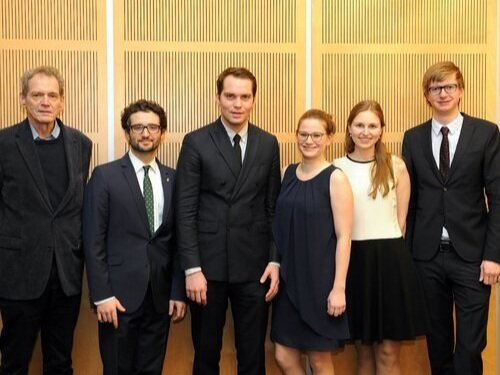Obermayer German Jewish History Award, Distinguished Service
Renata Stih and Frieder Schnock
Berlin
A few years after the Wall came down, Berlin city officials launched a competition for a work of public art honoring the memory of Berlin Jews who perished in the Holocaust. The conceptual artists Renata Stih and Frieder Schnock submitted their idea, and from 96 entries they won the competition.
In 1993, Stih and Schnock installed Orte des Erinnerns (Places of Remembrance), a Permanent street exhibition documenting the anti-Semitic laws and decrees enacted incrementally by the Nazis between 1933 and 1945. Composed of 80 obvious brightly painted signs affixed to lamp posts with short texts describing specific anti-Jewish restrictions. They are in the Bayerische Viertel (Bavarian Quarter) of Schoeneberg which was formerly a mostly middle class Jewish neighborhood in Berlin, where Albert Einstein and Hannah Arendt once lived. The signs alert passersby to dozens of specific laws passed by the Nazi government, from “Jews are excluded from sports groups. (April 25, 1933)”; “Jews may not use the public beach at Wannsee (August 22, 1933);” “Employment ban for Jewish actresses and actors.(March 5, 1934)”; “Employment forbidden for Jewish Musicians.(March 31, 1935)”; “Jewish doctors may no longer practice (July 25, 1938)”; “Jewish children are expelled from public schools (November 15, 1938)”’ and “Jews in Berlin are not allowed to buy food between four and five o’clock in the afternoon (July 4, 1940)”.
Nominator Elizabeth Pozen, a psychoanalyst and figurative painter describes it as follows. “The installation is meant to show the slow but systematic progression of the marginalization, isolation, discrimination, dehumanization, and destruction of Jews. The anti-Semitic laws and decrees, in some ways appearing initially banal or irritating, served to divide the Jews culturally – first from each other, and then from society at large. Over time this led “logically” to the total casting-out and murdering of thousands of people.”
In the two decades since their public art appeared, the installation has “educated people about the totalitarian and perverse thinking of the Nazis,” says Stih. “People were not ready to understand how consequential it was, how merciless it was. [The project] created some type of shock, because people were not used to this kind of truth in pure realism. No one had done a memorial before that way. We answered this system of the Nazis with a visualized system in public space.”
Exhibiting shortly after the reunification of East and West Germany, the art project emerged from what Stih calls “two systems of memory, which came together and created a new need to bring [the Holocaust] to the table and look at it again. As an artist one has other tools than historians and politicians – I think art is very powerful to discuss politics in public space because people are not exactly prepared for what [they see].”
After Orte des Erinnerns, Stih, who is a professor at Beuth Hochschule für Technik (Beuth University of Applied Sciences), and Schnock, who is an art historian, lecturer, curator, critic and art consultant as well as the education department director at Berufsverband Bilbender Künstler Berlin (Professional Association of Berlin Artists), became globally recognized for their work. Articles about the pair have appeared in the New York Times, New Yorker, Washington Post and Los Angeles Times. They have also lectured at major U.S. universities including the Art Institute of Chicago, Harvard, Princeton, Columbia and Brown University.
In addition, Stih and Schnock in 1994 created a “transitory” memorial artwork called BUS STOP for Berlin’s Holocaust Memorial, and produced a Munich map with stories called “The City As Text – Jewish Munich” for the opening of the Jewish Museum in Munich in 2007. This January, Stih and Schnock are installing a new art project that recognizes the Jewish heritage of the ancient city of Ostia, next to Rome.
Stih says it falls on others, not only Germans, to continue to question and publicly remember the role they played in the Holocaust. “Other European countries should also ask themselves what they have done during World War II and what they did to Jewish citizens,” she says.
“It is crucial to discuss the Holocaust, which shouldn’t be forgotten. I don’t think there is ever enough of this kind of discourse. If there is a need in society to recall or question the Holocaust, then it’s good – and every new generation will do the same, I hope. I hope there will be many more artists to come and work on the topic.”
THIS WALL BRINGS PEOPLE TOGETHER
Students at this Berlin elementary school, built on the site of a synagogue, have been building a wall for the past two decades. It delivers a powerful message about community.
STUDENTS REACHING STUDENTS
When a handful of ninth graders from Berlin met Rolf Joseph in 2003, they were inspired by his harrowing tales of surviving the Holocaust. So inspired that they wrote a popular book about his life. Today the Joseph Group helps students educate each other on Jewish history.
“I SPEAK FOR THOSE WHO CANNOT SPEAK”
Margot Friedländer’s autobiography details her struggles as a Jew hiding in Berlin during World War II. Now 96, she speaks powerfully about the events that shaped her life and their relevance today.



